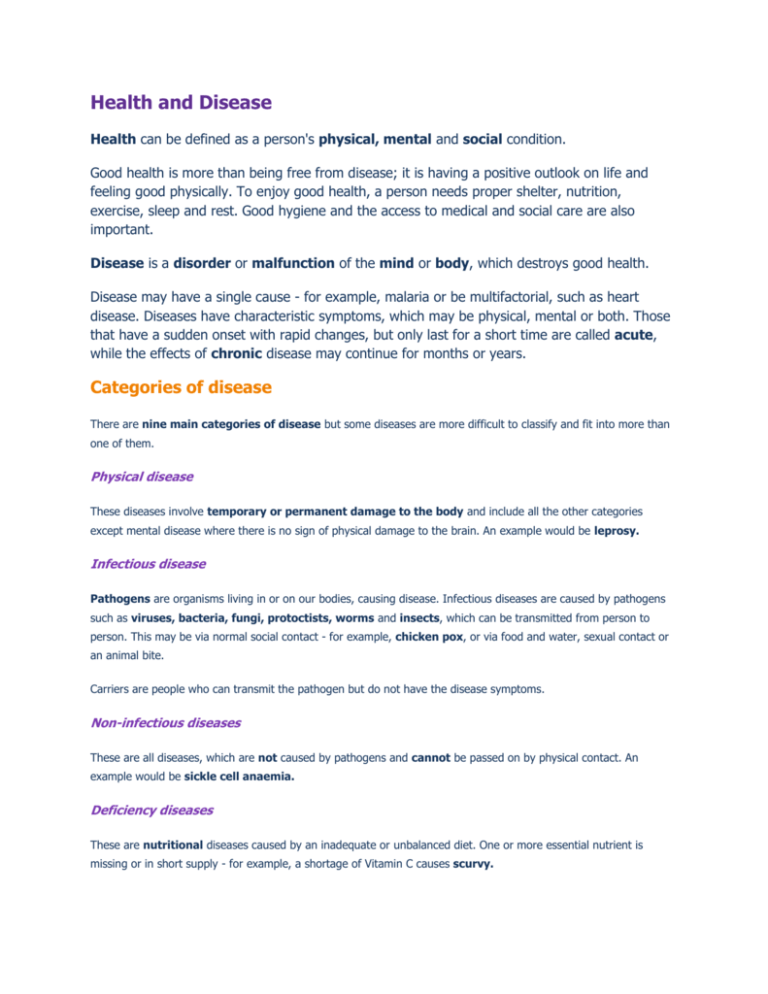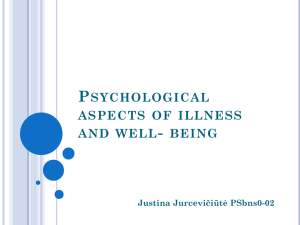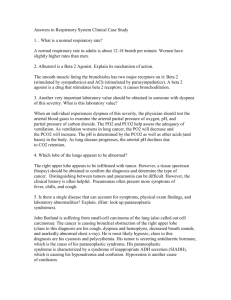Diseases - CAPE Biology
advertisement

Health and Disease Health can be defined as a person's physical, mental and social condition. Good health is more than being free from disease; it is having a positive outlook on life and feeling good physically. To enjoy good health, a person needs proper shelter, nutrition, exercise, sleep and rest. Good hygiene and the access to medical and social care are also important. Disease is a disorder or malfunction of the mind or body, which destroys good health. Disease may have a single cause - for example, malaria or be multifactorial, such as heart disease. Diseases have characteristic symptoms, which may be physical, mental or both. Those that have a sudden onset with rapid changes, but only last for a short time are called acute, while the effects of chronic disease may continue for months or years. Categories of disease There are nine main categories of disease but some diseases are more difficult to classify and fit into more than one of them. Physical disease These diseases involve temporary or permanent damage to the body and include all the other categories except mental disease where there is no sign of physical damage to the brain. An example would be leprosy. Infectious disease Pathogens are organisms living in or on our bodies, causing disease. Infectious diseases are caused by pathogens such as viruses, bacteria, fungi, protoctists, worms and insects, which can be transmitted from person to person. This may be via normal social contact - for example, chicken pox, or via food and water, sexual contact or an animal bite. Carriers are people who can transmit the pathogen but do not have the disease symptoms. Non-infectious diseases These are all diseases, which are not caused by pathogens and cannot be passed on by physical contact. An example would be sickle cell anaemia. Deficiency diseases These are nutritional diseases caused by an inadequate or unbalanced diet. One or more essential nutrient is missing or in short supply - for example, a shortage of Vitamin C causes scurvy. Inherited diseases These diseases are caused by genes and can therefore be passed from parent to child. They are also sometimes called genetic diseases or disorders. In Britain, the most common inherited disease is cystic fibrosis, which is characterised by a build-up of sticky mucus. This makes breathing difficult and can act as a breeding ground for bacteria, so sufferers need daily physiotherapy to remove the mucus. It is caused by a recessive faulty allele and so parents may be carriers for the disease without having any symptoms. As yet, genetic diseases may be treated but not cured because we cannot replace the faulty gene (gene therapy). The Human Genome Project involves scientists in many countries and began in 1990. It aims to: Determine the sequence of the bases throughout all the DNA in human cells. Identify the estimated 1000, 000 genes formed by the bases. Find the location of the genes on the 23 human chromosomes. Store all this information for research. Consider the ethical, legal and social issues arising from this information. The findings have already had a major impact, such as the devising of diagnostic tests to see if parents are carriers for a particular disease. In the future, drugs that act against the faulty gene causing a disease may be developed, which will have fewer side effects and be more effective. The replacement of faulty genes or gene therapy may become commonplace. Many people are concerned about the implications of genetic testing. In many cases there may be no treatment for a disease that we can test for. There are also risks of discrimination by employers, insurance companies and others if they discover an individual has a positive test for a faulty gene. How reliable will the test be? How will they be made available to the world's poorest nations? Degenerative diseases These diseases are characterised by a gradual loss of function, in one or several organs or tissues. In old age, this is often the result of the failure of the bodies repair mechanisms - for example, loss of mobility due to worn joints. However, degenerative diseases can strike in ones youth or middle age. They may be the result of poor nutrition in childhood or due to the immune system attacking the bodies, own cells. There are three main categories: Diseases of skeletal, muscular and nervous tissues - for example, osteoarthritis. Cardiovascular diseases of the circulatory system - for example, coronary heart disease. Cancers. Mental disorders These disorders affect a person's mind, but may be accompanied by physical symptoms. Emotions, thoughts, memories and personal and social behaviour can be affected. Some mental diseases are caused by degeneration of brain tissue - for example, Alzheimer's - a progressive deterioration in memory is followed by a general decline in all mental faculties (dementia). Other mental disorders seem to be accompanied by changes in the blood flow to the brain - for example, Schizophrenia. Social diseases This is a very wide category that can include almost all infectious diseases and multifactorial diseases, which are influenced by people's living conditions and their personal behaviour. For example, deficiency diseases may be the result of lack of choice of food, due to shortage of money. Self-inflicted diseases These diseases are caused by damage to a person's health by their own decisions and behaviour. Included in this category would be the choice to smoke or misusing drugs, sunbathing or eating a high fat diet. Deliberate self-harm, such as attempted suicide, could also be placed here although it is often an indication of poor mental health. Terms used to describe diseases An infectious disease, which is always present in a population, is called endemic. An epidemic occurs when a disease suddenly spreads rapidly and affects many people. If a disease spreads over a continent or even the world it will be termed pandemic. Health Statistics Epidemiology is the study of patterns of diseases and the factors affecting its spread. Incidence, prevalence and mortality for a disease may be determined. Collecting information on the distribution of disease helps to identify the underlying causes and if it turns out to be infectious, may point to how it is transmitted. Other causes such as the links between smoking and lung cancer may also be determined. The data on morbidity(numbers ill) and mortality (numbers who have died) for a disease when expressed in certain ways enables comparisons across cities or countries to be made. Statistics can be used to monitor the effectiveness of health provisions by both governments and the World Health Organisation (WHO). Global patterns of disease Data collected by WHO shows that in developing countries, the main cause of death is infectious diseases, while in developed countries, very few deaths are caused by pathogens. The reasons for this is that the incidence of infectious disease is low in developed countries due to vaccination, good standards of hygiene and nutrition, and the availability of antibiotics if they do contract one. Although globally health is improving, there are still many poor people in the world and poverty is responsible for the highest death rates in some countries. In the richer countries, degenerative diseases are the biggest killers. This is mainly due to lifestyles that put people at risk of heart disease and cancers. Smoking and Disease Tobacco companies do not declare the ingredients in cigarettes, but upon analysis, they contain over 4000 different chemicals, many of which are toxic. There are three main ingredients, which damage the gaseous exchange system or thecardiovascular system. Chemicals found in cigarettes Tar This is a mixture of aromatic substances, which settles on the airway linings and stimulates changes that may lead to obstructive lung disease and lung cancer. Carbon monoxide This gas diffuses across the alveoli into the blood and onto the red blood cells, combining with haemoglobin to formcarboxyhaemoglobin. This stops the haemoglobin from becoming fully saturated and so it carries 5-10% less oxygen. This places a strain on the heart as the heart muscle receives less oxygen and carbon monoxide can damage directly, the linings of arteries. Nicotine This drug is absorbed readily into the blood and stimulates the nervous system to reduce the diameter of arterioles and the adrenal glands to release adrenaline. This increases heart rate and blood pressure and decreases the blood supply to the extremities - for example, the hands and feet. Another effect is that platelets become stickier which, can lead to an increased risk of blood clots forming. Diseases Lung disease Chronic bronchitis Tar stimulates goblet cells and mucus glands to enlarge, producing more mucus. It destroys the cilia inhibiting the cleaning of the airways and mucus (containing dirt, bacteria and viruses) builds up blocking the smallest bronchioles. A smoker's cough is the attempt to move the mucus but it damages the epithelia resulting in scar tissue, which narrows the airways and makes breathing difficult. Infections like pneumonia may further inflame the linings resulting in a very severe cough and large quantities of phlegm. Emphysema Due to constant infection, phagocytes are attracted to the lungs where they release elastase - an enzyme that breaks down the elastin in the alveoli walls, to enable them to reach the surface where the bacteria are. Without adequate elastin, the alveoli cannot stretch, so they recoil and many burst. Large air spaces appear, reducing the surface area for gas exchange and making sufferers breath more rapidly. As it progresses, patients become breathless and wheezy - they may need a constant supply of oxygen to stay alive. Chronic obstructive pulmonary disease This very disabling disease is the result of chronic bronchitis and emphysema occurring together. Troublesome breathlessness often only occurs once half of the lung tissue has been destroyed, which can only rarely be reversed. Britain has the highest death rate from this disease in the world. Lung cancer Tar contains carcinogens, which react with the DNA in epithelial cells and cause mutations, which can lead totumours. Although it takes twenty to thirty years to develop, most growth of the tumour occurs prior to any symptoms, which include coughing up blood due to tissue damage. Once discovered, it's usually well advanced and requires surgery to remove it, followed up by chemotherapy or radiotherapy. Links Between Smoking and Disease These can be put into two groups: Epidemiological evidence looks for patterns in the diseases, which smokers suffer from. It only shows an association and not a causal link. Experimental evidence attempts to prove a causal link. Chronic obstructive pulmonary disease is very rare in non-smokers and 90% of deaths from it can be attributed to smoking. 98% of people with emphysema smoke and 20% of smokers suffer from it. Deaths from pneumonia and influenza are twice as high among smokers. Lung cancer is eighteen times more likely in smokers and one third of all cancer deaths can be attributed to smoking. 25% of smokers die from lung cancer and the risks are higher if they inhale, start young, smoke a large number of cigarettes a day and smoke over a long period of time. The risks of developing lung cancer fall as soon as smoking stops but it takes ten years for the risks to fall to that of a non-smoker. Experimental evidence includes the development of tumours in animals exposed to smoke and the identification of carcinogens in tar. Both lung cancer and chronic obstructive lung disease have been observed in dogs and tar has caused cancerous growths in the skin of mice. The cardiovascular system Cardiovascular diseases are degenerative diseases of the heart and circulatory system. They are responsible for 50% of deaths in developed countries and are multifactorial - smoking being one risk factor. Atherosclerosis This is caused by a build-up of fatty material in artery walls, which reduces the flow of blood and therefore oxygen to the tissues. An atheroma is a build up of cholesterol, fibres, dead muscle cells and platelets and is more likely to develop upon damage to the artery wall by high blood pressure, carbon monoxide or nicotine. Blood clots (thrombosis) become more likely and if one develops in the coronary artery a heart attack may be the result, while if it occurs in an artery supplying the brain, a stroke may result. Coronary heart disease This is a disease of the coronary arteries, which branch from the aorta, to supply the heart muscle. If atherosclerosis, of these vessels occurs, then the heart has to work harder and blood pressure rises. This makes it difficult for the heart to receive the extra nutrients and oxygen it requires during exercise. Three forms exist: Angina is severe chest pains upon exercising caused by a shortage of blood to the heart muscle but causes no death of heart tissue and stops upon resting. Heart attacks occur upon the blocking of a moderate branch of the coronary artery by a blood clot and cause starvation and death of heart tissue. Heart failure is when the coronary artery starts to block up and results in a gradual weakening of the heart. Stroke These occur if an artery in the brain bursts and blood leaks into the brain tissue or when an artery supplying the brain becomes blocked. The brain tissue becomes starved of oxygen and dies. Strokes can be fatal or very mild and may affect speech, memory and control of the body. Links between smoking and cardiovascular disease Smoking increases the concentration of blood cholesterol, which is a risk factor, so smokers increase the risk of having heart disease or a stroke. The risks of developing the disease increases with age and men are more at risk than women. Being overweight increases the risk as does eating a diet high in saturated fat and salt. Diets with more antioxidants (vitamins) and soluble fibre decrease the risk as does taking regular exercise. Having diabetes raises the risks and high alcohol intake is another contributory factor. This is a disease associated with affluence and is avoidable by a change in lifestyle. Treatments involve: Drugs to lower blood pressure, decrease risks of clots, reduce retention of fluids and decrease blood cholesterol. Coronary by-pass surgery involves the use of blood vessels from - for example, a leg to replace a diseased vessel and carry blood from the aorta to a place beyond the blockage. Heart transplants are very expensive and it is difficult to obtain matching tissue from donors. Better than treatment is obviously prevention. This can be achieved via education highlighting the risk factors and by screening for those most at risk. Unfortunately, bad eating and smoking are hard habits to kick.







